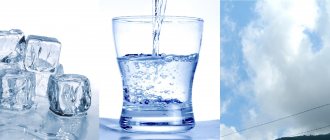The concept of "vitamins"
Vitamins are organic substances that come from outside or are synthesized in the body, participate in the construction of enzymes and hormones, which in turn act as regulators of various biochemical processes.
Beneficial substances include trace elements, essential amino acids and other vital substances that enter the body daily with food.
Microelements, like vitamins, are the basis of enzymes, specialized cells, and hormones. Essential amino acids are vital building materials. Contained in animal proteins.
Types of vitamins
Vitamin A is important for vision, normal skin and hair. The richest in it are liver and fish oil. B vitamins – are involved in energy metabolism. Contained in grains, cereals, meat, yeast. Vitamin C – together with vitamins A and E, prevent the formation of free radicals. It is important for connective tissues and iron absorption. Fresh vegetables and fruits are richest in vitamin C. Vitamin D can be produced in the human body independently, from cholesterol in the skin, under the influence of ultraviolet radiation. Regulates the exchange of phosphorus and calcium. Egg yolks, cream, and butter are rich in this vitamin. Vitamin E – reduces the risk of thrombosis, is important for good skin condition and muscle development. Contained in vegetable oils, spinach, beets, cabbage.
Vitamins and their importance for the human body
Before starting my research, I turned to the dictionary to find out the meaning of the word “vitamins.” Ozhegov’s “Explanatory Dictionary” gives the following explanation: “ VITAMIN is an organic substance, the primary source of which is usually a plant necessary for the normal functioning of the body, as well as a preparation containing such substances.”
Also, at the beginning of the study, it was found out what my friends and peers know about vitamins. For this purpose, a survey of 20 students from our school was conducted.
The following results were obtained:
- To the question “What are vitamins?” 50% answered that these are useful substances that our body needs.
- To the question “what vitamins do you know?” 70% answered that they know vitamins A, B, C.
- To the question “What foods contain vitamins?” 95% of children listed the names of different vegetables and fruits.
- From the answers to the question “Why should we take vitamins?” It was found that 88% believe taking vitamins is necessary to be healthy.
Thus, not everyone knows what vitamins are and what foods, except vegetables and fruits, contain them.
From scientific sources (books and encyclopedias, the Internet) it was found out when vitamins first appeared?
In the second half of the 19th century, people believed that the only beneficial substances contained in food were proteins, fats, carbohydrates, mineral salts and water. But because people did not eat certain foods and along with them other useful substances, besides those listed, they died from unknown diseases.
For example, when ships set out on long sea voyages, many people died from scurvy despite large food supplies. Scurvy is a disease in which a person feels tired, loses a lot of weight, loses appetite, has pain in the muscles in the legs, loose teeth and bleeding gums. Later it was discovered that scurvy develops from a lack of vitamin C.
For the first time, the Russian scientist Nikolai Lunin drew attention to unknown useful substances in 1880. He conducted experiments on mice and noticed that those animals that fed artificial milk lost weight and died. And those mice that received natural milk were healthy.
Later, his experience was confirmed by another scientist - doctor Eikman. At that time, in Japan and Indonesia, many people suffered from beriberi disease. This is a disease that affects the nervous system and heart and can lead to either paralysis or death. Aikman noted that he feeds his chickens husked rice, which is also what beriberi patients eat. As soon as you give them brown rice, they immediately recover.
The first scientist to isolate the vitamin was Casemir Funk in 1911. He gave it that name. “Vita” is translated from Latin as “life”, amines are a group of chemicals, hence the word “vitamin”.
Today, about 20 vitamins are known. All of them have been studied, it is known what products contain them and what diseases occur with their deficiency. Their chemical composition has also been studied, which makes it possible to obtain vitamins artificially.
Vitamin A
Vitamin A is fat-soluble, that is, it can be deposited in the liver and tissues. And this is a whole group of substances that are similar in chemical structure and retinol is the predominant active form that accumulates in tissues and in case of overdose, toxic reactions develop. The main source of retinol and other retinoids are animal products.
Vitamin precursors include carotenoids and carotene, the most important among them. You can find it in plant products. This provitamin is an antioxidant, and its main feature is that it “converts” into vitamin A only as needed, so there is practically no risk of overdose.
Role and benefits for the body:
- problems with vitamin deficiency
1) nyctalopia or “night blindness” – decreased visual acuity in low light; 2) predisposition to infectious diseases; 3) dry skin, red border of lips; 4) disorders of reproductive function; 5) growth retardation in children.
Vitamin A is found in foods such as:
- egg yolk, milk, liver, cheese and butter.
- and in the form of beta-carotene, the vitamin is found in spinach, carrots, zucchini, corn, mango and papaya.
Project work on the topic: “Vitamins”
Research methods:
qualitative reactions to vitamins A, E, C; observation, analysis, comparison.
As a result of research, these vitamins were not found in all products. Therefore, you need to be very careful when choosing products. The information written on the “labels” does not always correspond to real indicators.
1.
History of discovery and classification of vitamins.
Vitamins are complex organic substances of a non-protein nature that are present in food products in small quantities and play an important role in metabolism. The concentration of vitamins in tissues and the daily need for them are small, but with insufficient intake of vitamins, dangerous pathological changes occur in the body.
The importance of certain types of food in preventing certain diseases has been known since ancient times. So, the ancient Egyptians knew that the liver helps against night blindness. It is now known that night blindness can be caused by a lack of vitamin A. In 1330 in Beijing, Hu Sihui published a three-volume work, “Important Principles of Food and Drinks,” which systematized knowledge about the therapeutic role of nutrition and asserted the need for health to combine a variety of foods.
In 1747, Scottish physician James Lind, while on a long voyage, conducted a kind of experiment on sick sailors. By introducing various acidic foods into their diet, he discovered the property of citrus fruits to prevent scurvy. In 1753, Lind published his Treatise on Scurvy, which proposed the use of lemons and limes to prevent scurvy. However, these views were not immediately recognized. However, James Cooknan proved in practice the role of plant foods in preventing scurvy by introducing sauerkraut, malt wort and a kind of citrus syrup into the ship's diet. As a result, he did not lose a single sailor to scurvy—an unheard-of achievement for that time. In 1795, lemons and other citrus fruits became a standard addition to the diet of British sailors. This gave rise to an extremely offensive nickname for sailors - lemongrass. The so-called lemon riots are known: sailors threw barrels of lemon juice overboard.
In 1880, Russian biologist Nikolai Lunin from the University of Tartu fed experimental mice separately all the known elements that make up cow's milk: sugar, proteins, fats, carbohydrates, salts. The mice died. At the same time, mice fed with milk developed normally. In his dissertation (thesis) work, Lunin concluded about the existence of some unknown substance necessary for life in small quantities. Lunin's conclusion was met with hostility by the scientific community. Other scientists were unable to reproduce his results. One reason was that Lunin used cane sugar, while other researchers used milk sugar, which was poorly refined and contained some vitamin B.
Vitamin B
B vitamins are water-soluble vitamins, which means they do not require fat to be absorbed well by the body. Another feature is that they do not accumulate in the body (with the exception of B12), so they must be obtained from food daily.
Role and benefits for the body: how vitamin B is useful 1) B vitamins regulate metabolism; 2) normalize blood sugar levels; 3) strengthen the immune system; 4) reduce the negative impact of stressful situations on the body, acts as antidepressants.
Vitamin B is found in foods such as bread, pineapple, mango, beets, buckwheat, beans, meat, mushrooms, liver, kidneys.
Project “Vitamins are our friends”
Municipal budgetary preschool educational institution combined type kindergarten No. 7 “Fairy Tale” in the village of Mostovsky municipal formation Mostovsky district
project
"Vitamins are our friends"
Project type:
— According to the dominant activity in the project: cognitive - creative
-By the number of project participants: group (children, parents, teachers)
-By the nature of contacts: among children of the same group.
-By time: short-term (October).
Applicant: children of different age groups
Performed:
Educator M.S. Biryukova
Objective of the project:
To form in children ideas about proper nutrition and a healthy lifestyle.
Tasks:
Introduce the concept of “vitamins” and their role in human life.
Establish the relationship that health depends on proper nutrition (food should be not only tasty, but also healthy)
To clarify and enrich the knowledge of children and parents about the benefits of vitamins, how vitamins affect the human body.
To promote the creation of an active position of parents in the desire to eat healthy foods.
Clarification of concepts: “Fruits”, “Vegetables”, “Berry”. Develop the ability to generalize based on essential features.
To develop in children ideas about the benefits of vegetables, fruits, and berries for human health.
Develop ideas about vitamins and a healthy lifestyle.
Problems:
1. Doctor Aibolit comes to the children and says: “There is a flu in the city and in order not to get sick you need to take enough vitamins. What do you think vitamins are and where do they “live”?”
Problem situation:
– What are vitamins? What products contain them? How can vitamins help you avoid getting sick?
Children set themselves the task: Find out more about vitamins, collect material...
2. Activate the cognitive and speech activity of children through the integration of educational areas.
3. Ignorance by parents about the quantity, quality, variety of products, timeliness and regularity of intake is an important factor in preserving and strengthening the health of children.
Relevance of the project:
The most pressing problem today is strengthening the health of children. V. A. Sukhomlinsky wrote: “I am not afraid to repeat again and again: caring for the health of a child is the most important work of a teacher.” Health is considered as complete physical, mental and social well-being, as a harmonious state of the body, which allows a person to be active in his life and achieve success in various activities. Deterioration in the quality of nutrition and lack of vitamins and microelements in food negatively affect the physical development of children. To achieve harmony with nature, you need to learn to take care of your health from childhood. It is in childhood that the foundations for a healthy organization of a child’s life for the future are laid. Therefore, it is so important to give children an idea about vitamins, their benefits for human health, and the content of certain vitamins in vegetables and fruits.
Vitamin C
Vitamin C, or ascorbic acid, is a water-soluble vitamin that has powerful antioxidant properties. It performs many functions in the human body and is an important component of tendons, ligaments, blood cells, skin, bones and teeth.
Role and benefits for the body: what are the benefits of vitamin C 1) participates in the production of red blood cells in the bone marrow; 2) is responsible for hemoglobin in the body; 3) Ascorbic acid maintains the good condition of capillaries, gums, teeth;
Vitamin C is found in foods such as:
Grapefruit, guava, lemon, mango, tomatoes, strawberries, black currants, broccoli, oranges, Brussels sprouts, bell peppers, papaya, rose hips, spinach, tangerines.
Synthetic and natural vitamins
Vitamins obtained chemically can also enter our body. These are various multivitamin complexes that are sold in pharmacies in our city.
Of course, to improve health and prevent diseases, preference should be given to natural vitamins found in food. The same problem arises when the body’s need for vitamins increases, and especially in diseases that impair their absorption.
Although many vitamins can be synthesized artificially, most vitamin preparations (tablets, capsules, powders, liquids) are produced using natural sources.
For example, vitamin A is obtained from fish liver oil; B vitamins—from yeast or liver; vitamin C is considered the best if it is made from rose fruits, or more precisely from rose hips; Vitamin E is extracted mainly from soybeans, wheat germ or other grains, etc.
Chemical analysis shows that the resulting preparations do not differ from natural vitamins, but, as a rule, the latter have a more pronounced positive effect and do not cause adverse reactions. Why?
Firstly, food products usually contain a whole complex of substances that have similar vitamin activity, and not just one substance. For example, natural vitamin E can include all of the naturally occurring tocopherols, rather than just tocopherol alone, so it is more effective than its synthetic counterpart.
Secondly, food products contain various vitamins and biologically active substances that enhance each other’s effects (improving absorption and slowing down excretion). Synthetic vitamin C is only ascorbic acid and nothing else. Natural vitamin C, extracted from rose hips, contains a whole complex of vitamins C, as well as bioflavonoids (vitamin P). Therefore, natural vitamin C is much more effective.
An experiment to determine the presence of vitamin C in various vegetables, fruits and industrial juices
Very often we hear that we need to take vitamin C to get sick less.
I was wondering which foods contain the highest content of this vitamin. To determine the amount of vitamin C in foods, I conducted a study. Objects of research: orange, apple, black currant, red pepper, lemon, kiwi. Research methods: IODOMETRY, Let's determine the presence of vitamin C in vegetables and fruits using iodometry.
For this:
- measure out 20 ml of squeezed juice of various fruits and berries and dilute it with water to a volume of 100 ml;
- add starch paste;
- add 5% iodine solution drop by drop until a stable blue color appears, which does not disappear within 10-15 seconds.
- Observe the color change for 1 minute. We record the results in a table.
Research on the amount of vitamin C in vegetables and fruits
| Product | Number of iodine drops | Result |
| Orange | 10 | 12.25 mg |
| Lemon | 8 | 9.8 mg |
| Red pepper | 24 | 29.75 mg |
| Kiwi | 6 | 7.49 mg |
| Apple | 6 | 7.49 mg |
| Black currant | 48 | 59.85 mg |
From this table we can conclude that the largest amount of vitamin C is contained in black currants and red pepper.
Study of industrially produced juices for the presence of vitamin C.
Research method: IODOMETRY,
| Product | Number of iodine drops | Result |
| Juice "Apple" ("Good") | 3 | 4.0 mg |
| Juice “Apple” (“Gardens of the Don region”) | 4 | 4.9 mg |
| Juice “Multifruit” (“Gardens of the Don region”) | 4 | 11.2 mg |
| Orange juice | 9 | 11,25 |
From this table we can conclude that the largest amount of vitamin C in industrially produced juices is contained in the Multifruit and Orange juices.
Conclusion
After studying information about the effect of vitamins on the body, I realized that vitamins play a very important role in human life. Without eating them, we can get very sick. Therefore, you need to eat right and constantly eat fresh fruits, vegetables and other foods containing large amounts of nutrients.
For children, vitamins are especially important; the level of mental and physical performance, endurance and resistance of the body to the influence of adverse environmental factors depends on them.
Now I know that each vitamin is responsible for its own part of the body: A - improves vision and skin, improves immunity, group of vitamins B - promotes growth, reduces toothache, and so on. Therefore, all vitamins are equally useful; none of them can be excluded from the diet.
My hypothesis was confirmed!
Vitamin D
Vitamin D is a fat-soluble vitamin that comes in two forms—vitamin D₃ and vitamin D₂. D₃ is synthesized in the skin under sun exposure and is found in foods that naturally contain the vitamin.
Role and benefits for the body: what is vitamin D useful for?
1) vitamins D regulate the metabolism of calcium and phosphorus; 2) vitamin D prevents the formation and growth of tumors; 3) prevents the destruction of neuronal myelin sheaths; 4) promotes normal myocardial function.
Vitamin D is found in such products as: sea fish, caviar, eggs, liver, sour cream, cheese, butter, milk.




